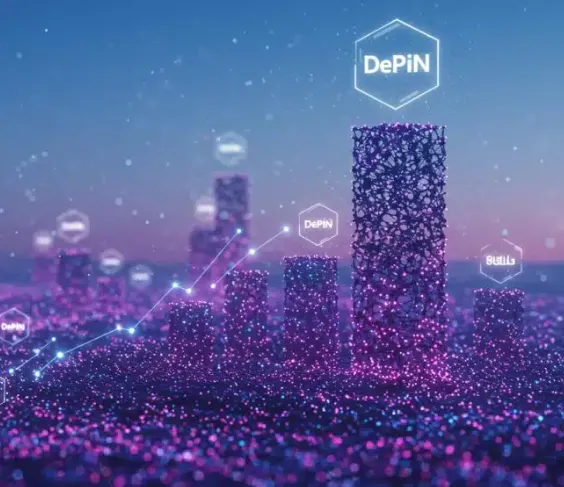For years, infrastructure development and management within the blockchain ecosystem have been centralized, with large corporations and governments holding most of the power. However, the rise of Decentralized Physical Infrastructure Networks (DePIN) is reshaping this narrative by providing a decentralized, community-driven approach.
DePIN is an innovative model that combines blockchain technology, tokenization, and smart contracts to create a platform where infrastructure is collectively managed by a network of participants. This new system aims to address the limitations of traditional infrastructure models by democratizing access to essential resources like energy grids, telecommunications networks, and data storage systems.
How Do DePINs Work?
DePINs operate by using blockchain to create decentralized platforms for sharing physical resources. Think of it as a peer-to-peer network where communities can directly participate in the infrastructure economy. This model makes systems like data storage or unused computing power more equitable and efficient by allowing individuals and businesses to contribute and benefit from the infrastructure.
What Makes DePINs Unique?
According to a 2023 report from Messari, the DePIN market could reach $3.5 trillion by 2028, signaling a massive shift in how we build and manage infrastructure. So, what sets DePINs apart from traditional models?
- Decentralization and Tokenization
DePINs operate in a decentralized environment, spreading control across a network of participants. This creates a more transparent, community-driven system. Tokenization plays a vital role in incentivizing participation. Participants who contribute resources, such as bandwidth, storage, or energy, earn tokens, while users pay with tokens to access the infrastructure. These tokens aren’t just rewards—they also act as governance tools, allowing participants to have a say in the operation of the network. This encourages widespread adoption and engagement, as users feel empowered and valued. - Accessibility and Scalability
One of the key strengths of DePINs is their ability to break down traditional barriers, making critical infrastructure accessible to a broader range of users. This democratization of resources levels the playing field, allowing individuals and companies of all sizes to participate in the digital landscape. Additionally, because DePINs are built on blockchain technology, they can scale efficiently, adapting to growing user demands while maintaining transparency and security. - Community-Driven Development
Unlike traditional infrastructure models, which are often managed by centralized authorities, DePINs are shaped by the communities that use them. This community-driven approach fosters innovation and resilience, as participants are directly invested in the development and maintenance of the infrastructure.
Challenges and Risks of DePINs
While the potential for DePIN projects to revolutionize industries is immense, they also face several challenges that could slow their widespread adoption:
- Hardware Integration
DePINs often require various physical devices, each with its own specifications and requirements. Integrating hardware from different manufacturers and ensuring compatibility across devices can be a significant challenge. For DePINs to succeed, it is essential to ensure smooth integration and communication between all devices involved. - Regulatory Issues
The regulations currently in place are designed for centralized infrastructures and may not adequately address the unique needs of DePINs. Governments will need to update and adapt laws to create a supportive regulatory environment for decentralized infrastructure. Additionally, as many DePINs operate across international borders, global cooperation will be necessary to bridge regulatory gaps. - Scalability and Efficiency
As DePIN networks expand, they must be able to handle an increasing number of users and transactions. This requires highly efficient infrastructure and scalable protocols. Techniques like layer-2 and layer-3 blockchain solutions, along with sharding, will become essential to maintain the decentralization and cost-effectiveness of these networks. - Interoperability and Standardization
Currently, DePIN projects often operate on different blockchains, each with its own standards and protocols. To create a more interconnected infrastructure ecosystem, interoperable solutions, such as cross-chain bridges, will be necessary. Additionally, adopting common technical standards will help streamline operations and attract more developers to the space.
Popular DePIN Projects to Watch
- Fone Network
Fone Network is a blockchain built specifically for mobile devices, designed to create an instant and accessible transactional network. With over 5.4 million downloads and 120,000 monthly active users, Fone focuses on simplicity and emphasizes community engagement to enhance interactivity. - Filecoin
Filecoin is a decentralized storage network that utilizes blockchain technology to transform data storage and retrieval. By incentivizing users to share unused storage space, Filecoin creates a distributed, secure, and private storage network, providing a decentralized alternative to traditional cloud storage solutions. - Helium
Helium is a decentralized wireless network that uses blockchain to offer affordable, long-range connectivity for IoT devices. Through incentivizing users to deploy and maintain network infrastructure, Helium enables a scalable and secure platform for data transmission, transforming how devices communicate on a global scale.
Final Thoughts
DePINs represent a groundbreaking development in the way we think about and manage infrastructure. By leveraging blockchain and decentralization, these networks promote efficiency, transparency, and the democratization of resources. However, achieving mainstream adoption will require overcoming challenges like scalability, regulatory hurdles, and the need for interoperability.
To succeed in the rapidly evolving DePIN ecosystem, projects will need strategic support and guidance. Collaborating with Web3 advisors and incubators, such as TDeFi, can help these projects scale, ensuring they emerge as leaders in the decentralized infrastructure space.







